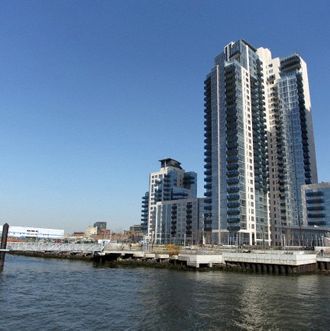
Even as the sea has grown more threatening, New York has moved towards it. A couple of decades ago, we hung back from the city’s fenced-off, polluted, and invisible edges. The low ground by the water had been left to dirty, declining businesses like shipping and manufacturing; the rest of us crossed bridges slung far above the water and gazed on rivers from the safety of upper floors. Some days, the wind blew off the Atlantic, brining the air over Manhattan and reminding us that we lived in a maritime city; otherwise, it was easy to forget.
But the storm that crashed into town this week found a sea-besotted city, one ringed with a green ribbon of leisure and luxury. Tribeca, Battery Park City, West Chelsea — these once-fallow (or nonexistent) lowlands are now premium zip codes. We have become like the New Yorkers that Melville described, people who “must get just as nigh the water as they possibly can without falling in.” Sandy won’t change that. It’s too late to roll back the Williamsburg waterfront, unbuild Brooklyn Bridge Park, cancel the development of Governors Island, or write off Belle Harbor. Instead, what if New York could become a pioneer of urban life in an era of climate change? Instead of retreating, denying, or despairing, we’d be inhabiting our fragile ledge with foresight and aplomb, reengineering the post-industrial shoreline to emulate its pre-urban state. Our best future resembles the past.
In coming decades, as warmer seas whip up ferocious storms on a semi-regular basis, we’ll learn to recognize the sight of a bruise-colored East River muscling its way onto city streets. We’ll become familiar with floods, perhaps not quite so intimately as Venetians know their acqua alta but enough so that we stop letting them strand us temporarily in the nineteenth century.
The waters that tore up New York behaved like invading barbarians, smashing into seawalls, vaulting over bulkheads, hurtling along gutters, rushing towards clogged storm drains, and overwhelming sewage-treatment plants. That’s partially our fault. Like most cities, New York is built to beat back the sea’s spasms of violence, not to absorb them. The very first item on Governor Andrew Cuomo’s post-Sandy shopping list was a set of massive levees: Build a high wall, and we’ll happily hunker behind it. Dutch-style dikes may be part of the package —but how high is high enough? The truth is that we don’t know. Predictions change, and threats evolve. Try to repel the last storm by building a $10 billion, seventeen-foot barrier at the mouth of New York Harbor, and in a couple of decades — or a couple of years — it could well be stampeded by a twenty-foot surge.
Imagine, instead, a city that learns to embrace nature rather than vainly try to fight it. The streets of low-lying areas are paved with permeable surfaces, allowing floodwaters to seep through rather than slosh into basements. Tall grasses dance in a spongy buffer zone of marshland, stretching from the built edge out into the waterways. Scattered in the Upper Bay are archipelagos of tiny artificial islands and floating piers — speed bumps for a storm surge. Beneath the waves, submerged reefs made of old subway cars and oyster beds help diffuse hard-charging currents, and at the same time host an abundance of marine life. In that New York, we will watch the sea come in, serenely confident that it will make an orderly retreat, leaving our vital systems unmolested and our streets unbesmirched.
To ready coastal cities for the water next time will take an effort of Manhattan Project dimensions, but it’s not an idle daydream. After the Loma Prieta earthquake in 1989, a nationwide army of experts developed new ways to cushion bridges, roads, power plants, and skyscrapers from seismic shocks. “It was a real renaissance,” says the structural engineer Guy Nordenson, who advocates a similar deployment of human ingenuity to face the dangers of flooding. It’s already begun. The 2010 MoMA show Rising Currents arrayed some startling visions of a more water-friendly future for New York. Some of those ideas have already percolated into reality — at Brooklyn Bridge Park, for instance, where the storm dunked the salt marshes and rocky riprap edges but then left them unscathed.
Along with the decimation it wrought, Sandy also performed New York a service. Until this week, re-redesigning the waterfront seemed like a leisure-time extra. Now it’s become urgent business. And the appalling cost of cleaning up our urban floodplain makes a soft-edged shore feel like that great necessity of New York life: a bargain. The goal is not a dry city, but a resilient one.






























